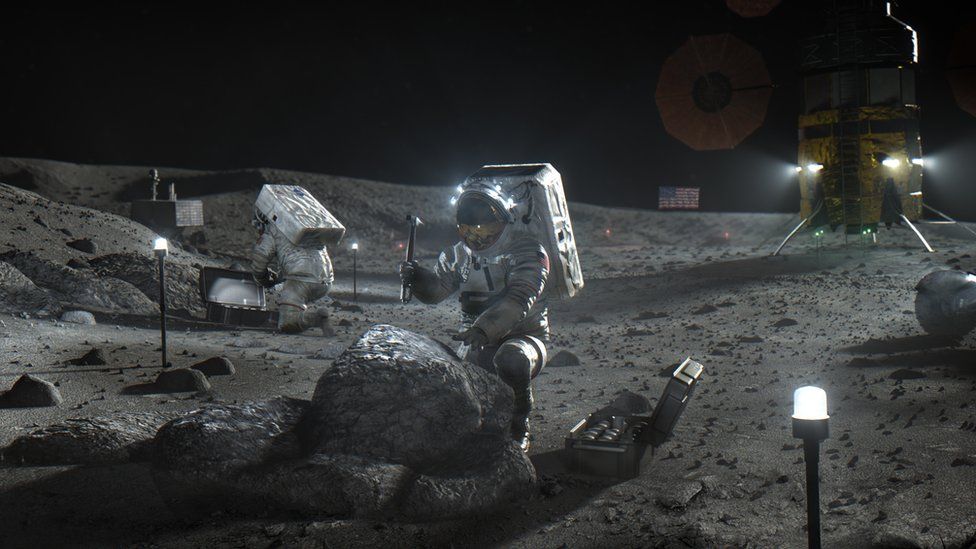““Asteroid Mining May be a Reality by 2025,” published by us (Space.com) in August 2015. Back then, “Planetary Resources had deployed its first spacecraft and Deep Space Industries was showing pretty pictures of its spacecraft, with the companies more than happy to tell everyone that they were in pole position to turn far away rocks into earthly profit…
“A decade later, both companies are gone”. TODAY, the Asteroid Mining Corporation (AMC), AstroForge, Karman+, and TransAstra are among the start-ups that want to be a part of the second wave of space mining, but one company clearly seems to be ahead of the pack.”
And instead of lots of talk, “AstroForge launched its first mission in April 2023 to demonstrate its refinery technology operating in space. It failed, but its second mission is on deck for launch sometime this year with the Odin spacecraft expected to be the first to collect images of an M-type (or M-class) asteroid (that is, “metallic-type) a spectral class of asteroids which appear to contain higher concentrations of metal.”
“More importantly, AstroForge has cash, is being transparent in how its first mission failed and what it needs to accomplish to fly Odin ( new probe), and has a path charted out for a third mission, Vestri, which will revisit the M-type asteroid and attempt to land…”
“TransAstra, which currently has products to track and spot objects in space, giving it the ability to bring in space domain awareness (SDA) revenue while it works on capture bags for ‘snagging and bagging’ satellites and recycling orbital debris into resources. This technology R&D leads to its Honey Bee asteroid mining vehicle, which would capture an asteroid and optically mine (here’s the definition of “optically mining…using concentrated sunlight to heat and vaporize volatile materials (like water ice) from asteroids, which are then collected and processed [to analyze it] for resources such as water and metals.”
Wasn’t sure what “optically mine” an asteroid was – sounded like they take pictures and then send them to the highest bidder. That doesn’t seem wise at the moment, as the highest bidder will likely be one of their main competitors…but who am I but an old science fiction writer? Turns out they’ll use an onboard laser to zap rock samples, and check them for wealth.
Seems there are OTHER players that are nowhere near as far along as AF and TA: “Karman+ has raised $20 million towards building an asteroid water mining mission, with a target launch window in 2027…”
“AMC is building autonomous ruggedized (???) six-legged robots that could be used on Earth in hazardous environments as well as in space with the ability to coordinate operations in swarms for inspection and other duties. AMC expects to conduct an on-orbit demonstration of its SCAR-E (Space Cargo and Reconnaissance – Explorer) robot in 2026 with deployments onboard the International Space Station and the lunar surface in the 2026-2027 timeframe.”
OK – so the quest continues with lots of companies spending money to see if mining the asteroids is REALISTIC and will (above all else) MAKE THEM MONEY.
These last contenders seem to have drifted farther and farther from reality and more into the fantasy that devoured PR and DSI. Also clear is that mining in space will be FAR more difficult than mining on Earth is…
Or is it? The website EARTH SYSTEMS points out, “…it seems the majority of the news we hear about mining is negative. However, it is important to remember how important mining is to our civilization and standard of living. It’s interesting to reflect on how we reached our current perception of mining because, during most of our history, mining has had priority over most other activities.” They point out that “…mining started as a search for the stone tools. Objects we’ve unearthed that are clearly primitive tools “are approximately 2.6 million years old, predating even Homo Sapiens.”
So humans and humanoids have been mining for a long, long time. Eventually, humans started digging iron out of rocks that had fallen from the skies: aka meteorites. “Dated to around 1400 BC, several iron axes from Shang dynasty China were confirmed to be meteoritic in origin; from around the same time, an iron dagger, bracelet and headrest from the tomb of Tutankhamun were confirmed to be meteoritic in origin”.
One could almost say that mining the asteroids is the destiny of modern Humanity.
Admittedly, it’s not HERE AND NOW, but I don’t think, based on what I’m reading now, that it’s all that far away. Of course, starting to mine the asteroids may very well lead to some bumps and bruises for the Human race in the future…
NEXT TIME: A bit of history of mining ON EARTH...was it REALLY as easy as we pretend it is?
Today’s Source: https://www.spacecomexpo.com/spacecom-column/space-mining-time-now ; https://en.wikipedia.org/wiki/M-type_asteroid ; https://www.earthsystems.com/history-mining/ ; https://en.wikipedia.org/wiki/Meteoric_iron
Foundational Resource: (A general Wikipedia post detailing what the authors currently know about asteroid mining: https://en.wikipedia.org/wiki/Asteroid_mining)
Noted Resources: https://en.wikipedia.org/wiki/List_of_asteroid_close_approaches_to_Earth, https://www.pharostribune.com/news/local_news/article_7fcd3ea5-3c14-533f-a8d5-9bf629922f34.html, https://www.fool.com/investing/2022/04/29/like-asteroid-mining-be-careful-what-you-wish-for/, https://www.nps.gov/wrbr/learn/historyculture/theroadtothefirstflight.htm, https://hackaday.com/2019/03/27/extraterrestrial-excavation-digging-holes-on-other-worlds/, https://www.planetary.org/space-missions/every-small-worlds-mission
Interesting Stuff The Might Apply To Mining Asteroids: https://www.bbc.com/news/articles/cgej7gzg8l0o
Today’s Source: https://www.spacecomexpo.com/spacecom-column/space-mining-time-now ; https://en.wikipedia.org/wiki/M-type_asteroid ; https://www.earthsystems.com/history-mining/ ; https://en.wikipedia.org/wiki/Meteoric_iron
Foundational Resource: (A general Wikipedia post detailing what the authors currently know about asteroid mining: https://en.wikipedia.org/wiki/Asteroid_mining)
Noted Resources: https://en.wikipedia.org/wiki/List_of_asteroid_close_approaches_to_Earth, https://www.pharostribune.com/news/local_news/article_7fcd3ea5-3c14-533f-a8d5-9bf629922f34.html, https://www.fool.com/investing/2022/04/29/like-asteroid-mining-be-careful-what-you-wish-for/, https://www.nps.gov/wrbr/learn/historyculture/theroadtothefirstflight.htm, https://hackaday.com/2019/03/27/extraterrestrial-excavation-digging-holes-on-other-worlds/, https://www.planetary.org/space-missions/every-small-worlds-mission
Interesting Stuff The Might Apply To Mining Asteroids: https://www.bbc.com/news/articles/cgej7gzg8l0o


No comments:
Post a Comment